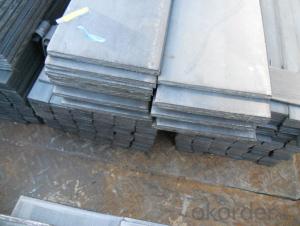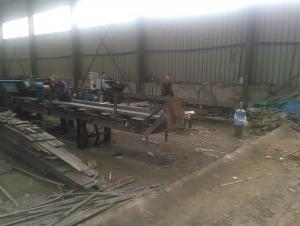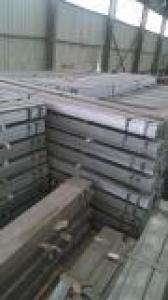hot rolled high quality GB Q235 flat bar
- Loading Port:
- Tianjin
- Payment Terms:
- TT OR LC
- Min Order Qty:
- 25 m.t.
- Supply Capability:
- 24000 m.t./month
OKorder Service Pledge
OKorder Financial Service
You Might Also Like
lat bar Details:
| Minimum Order Quantity: | Unit: | m.t. | Loading Port: | ||
| Supply Ability: | 10000 | Payment Terms: | Package: | Steel Packing |
Product Description:
Product Description:
Specification of Mild Steel Flat Bar
Commodity: Mild Steel Flat Bar
Standard: GB;JIS
Material: Q195-235;SS400
Brand name: FLATSPACE
Origin place: China
Thickness: 3mm-30mm
Width:20mm-200mm
Length: Max 12m
Certification: SGS/BV
Chemical composition of Q235
Alloy No | Grade | Element(%) | ||||
C | Mn | S | P | Si | ||
Q235 | B | 0.12—0.20 | 0.3—0.7 | ≤0.045 | ≤0.045 | ≤0.3 |
Physical properties of Q235
Alloy No | Grade | Yielding strength point(Mpa) | Tensile strength (Mpa) | Elongation after fracture(%) | ||||||
Thickness (mm) | Thickness (mm) | |||||||||
≤16 | >16--40 | >40--60 | >60--100 | ≤16 | >16--40 | >40--60 | >60--100 | |||
≥ | ≥ | |||||||||
Q235 | B | 235 | 225 | 215 | 205 | 375--500 | 26 | 25 | 24 | 23 |
Usage/Applications of Mild Steel Flat Bar
Widely used for construction, Machinery manufacturing, Iron tower steel structure, Shipbuilding; Steel grating, Staircase, Bridge, Viaduct, Railway spare parts, Boilers making etc.
Packaging & Delivery of Mild Steel Flat Bar
Packaging Details: The Mild Steel Flat Bars are packed in bundles and loaded in 20 feet/40 feet container, or shipped by bulk cargo ,also we can do as customer's requirements.
Delivery Details:30~45 days upon the receipt of buyer payment by T.T. or L/C.
Production Flow of Mild Steel Flat Bar
The Mild steel flat bar is made through three processes:
1.Feeding the material: Feeding the row material (the steel plate) to Slitting Line.
2.Slitting:The steel plate would be slitted into expected width by lengthways cutter.
3. Leveled and cutting: The plat bar would be ground into level by the grinder and then cut into required length
- Q: Are steel flat bars available in different surface finishes?
- Steel flat bars come in various surface finishes, providing different options for buyers. Some examples of common surface finishes for steel flat bars are mill finish, hot rolled, cold rolled, brushed, polished, and galvanized. Each surface finish possesses its own distinct characteristics and is suitable for different purposes. Mill finish is the initial surface finish achieved after manufacturing steel, while hot rolled steel flat bars have a rougher texture and are commonly used for structural applications. On the other hand, cold rolled steel flat bars have a smoother surface finish and are often utilized in decorative applications. Brushed and polished finishes offer a more refined and aesthetically pleasing appearance. Meanwhile, galvanized steel flat bars are coated with zinc to provide protection against corrosion. In summary, the availability of various surface finishes allows steel flat bars to be utilized in a wide range of applications, while also meeting specific requirements for appearance and functionality.
- Q: How do steel flat bars contribute to the overall durability of commercial structures?
- Steel flat bars contribute to the overall durability of commercial structures in several ways. Firstly, steel is known for its high strength and durability, making it an ideal material for construction. Steel flat bars have a high tensile strength, meaning they can withstand heavy loads and resist bending or warping under pressure. This strength allows commercial structures to support the weight of various elements, such as floors, walls, and roofs, ensuring their stability over time. Additionally, steel flat bars are resistant to corrosion, which is crucial in commercial structures where exposure to moisture and harsh weather conditions is common. Unlike other materials like wood or concrete, steel does not rot or deteriorate when exposed to water or moisture. This corrosion resistance helps prevent structural damage, ensuring the longevity and safety of the commercial building. Moreover, steel flat bars are highly versatile and can be customized to fit specific design requirements. They can be easily cut, drilled, and welded, allowing for flexibility in creating complex and intricate structures. This adaptability in design ensures that commercial structures can be constructed efficiently and with precision, resulting in a more durable and reliable building. Another important aspect is the fire resistance of steel flat bars. Steel is inherently non-combustible, meaning it does not contribute to the spread or intensity of fires. This fire-resistant quality makes steel flat bars a preferred material for commercial structures, as it enhances the safety of occupants and minimizes the potential for structural damage in the event of a fire. Lastly, steel flat bars are often used in reinforcement applications. They can be embedded within concrete structures, such as beams or columns, to enhance their load-bearing capacity. This reinforcement adds an extra layer of strength and durability to the commercial building, ensuring its ability to withstand heavy loads and potential impacts. In summary, steel flat bars contribute to the overall durability of commercial structures through their high strength, corrosion resistance, versatility in design, fire resistance, and reinforcement capabilities. Their incorporation in construction ensures the longevity, safety, and stability of commercial buildings, making them an essential component in the construction industry.
- Q: Can steel flat bars be used for making hand tools?
- Yes, steel flat bars can be used for making hand tools. Steel is a strong and durable material, making it suitable for crafting various hand tools such as wrenches, screwdrivers, chisels, and more. The flat shape of the bar can easily be shaped and manipulated into the desired tool design.
- Q: Are steel flat bars suitable for making material handling systems or equipment?
- Indeed, steel flat bars present a highly suitable option for the fabrication of material handling systems or equipment. Renowned for their strength, durability, and versatility, steel flat bars prove to be an ideal choice for applications necessitating robust support and load-bearing capabilities. They offer the convenience of easy weldability, cutting, and the ability to be shaped into various dimensions and forms, thereby enabling customization to meet specific requirements. In the realm of material handling, systems and equipment frequently encounter substantial loads and endure frequent usage. In such demanding conditions, steel flat bars emerge as an outstanding choice. They exhibit remarkable resistance to impact, abrasion, and corrosion, ensuring long-lasting performance. Moreover, their rigid structure guarantees stability and reliability, effectively minimizing the likelihood of equipment failure or material handling mishaps. What's more, steel flat bars are conveniently available in multiple grades and finishes, including hot-rolled or cold-rolled options, thereby allowing for the selection of the most suitable material for the intended application. They prove to be invaluable in the construction of diverse components within material handling systems, such as frames, supports, guides, and brackets, providing a sturdy and dependable infrastructure. Overall, steel flat bars inherently possess the essential characteristics required to effectively manage materials in a wide range of industrial settings. Their strength, durability, versatility, and availability render them an exceptional choice when it comes to fabricating material handling systems or equipment.
- Q: What does QB stand for in Q235B flat steel? What's the difference between Q235B and Q235A?
- Low alloy steel Q235A and Q235B in A, B is the difference between the level of quality (total seems to be divided into four levels, you can check and confirm), the main difference is whether it is necessary to do the normal impact test, A does not need to do, need to do B.
- Q: Galvanized flat steel how much is one meter?
- The price of galvanized flat steel is about 6200, so the price is 40 * 4 * 0.00785 * 1.06 * 6.2=8.3 yuan per meterGalvanized pipe price is about 6500, DN25:2.57 * 6.5=16.7 yuan / meter, DN32:3.32 * 6.5=21.58 yuan / meterAngle steel price 5000, 4# angle steel: 2.422 * 5=12.1 yuan / meter
- Q: Can steel flat bars be used for making brackets or supports for HVAC systems?
- Yes, steel flat bars can be used for making brackets or supports for HVAC systems. Steel is a strong and durable material, making it suitable for supporting the weight and load of HVAC components. Steel flat bars can be easily cut, bent, and shaped to the desired dimensions, allowing for custom brackets or supports to be fabricated. Additionally, steel has excellent corrosion resistance properties, ensuring that the brackets or supports will remain stable and reliable over time. Overall, steel flat bars are a common and practical choice for manufacturing brackets or supports for HVAC systems.
- Q: What is the maximum temperature steel flat bars can withstand?
- The specific grade of steel and its intended use determine the maximum temperature that steel flat bars can endure. In general, carbon steel can tolerate temperatures of approximately 600-800 degrees Celsius (1112-1472 degrees Fahrenheit) before it begins to compromise its structural integrity and mechanical properties. Nonetheless, certain alloy steels can withstand even higher temperatures due to their improved heat resistance characteristics. To determine the maximum temperature limit for a particular steel flat bar, it is essential to refer to the manufacturer's material specifications and guidelines. Furthermore, factors such as exposure duration, load, and cooling rate can also influence the maximum temperature that steel flat bars can withstand.
- Q: Can steel flat bars be used for making aerospace industry equipment or structures?
- Steel flat bars can certainly be used for making aerospace industry equipment or structures. Steel is a widely used material in the aerospace industry due to its high strength, durability, and resistance to extreme temperatures. Flat bars, in particular, are often utilized in aerospace applications for their versatility and ease of use. Steel flat bars can be used to fabricate various components and structures in the aerospace industry, such as frames, supports, brackets, and fittings. These bars can be easily cut, shaped, and welded to meet the specific design requirements of aerospace equipment. Additionally, steel flat bars offer excellent load-bearing capabilities, making them suitable for applications that require high strength and stability. However, it is important to note that the specific type of steel used for aerospace applications must meet stringent quality and performance standards. The aerospace industry often requires materials with exceptional mechanical properties and resistance to corrosion and fatigue. Therefore, steel flat bars used in the aerospace industry must undergo rigorous testing and certification processes to ensure their suitability for these demanding applications. In conclusion, steel flat bars can be effectively used for making aerospace industry equipment or structures. With their strength, versatility, and ease of fabrication, steel flat bars are a valuable choice for various components in the aerospace industry, provided that they meet the required quality and performance standards.
- Q: What are the different types of surface defects in aluminum steel flat bars?
- There are several different types of surface defects that can occur in aluminum steel flat bars. Some common ones include: 1. Scratches: These are visible marks or abrasions on the surface of the flat bar caused by contact with a hard object or rough handling during manufacturing or transportation. 2. Dents: Dents are depressions or concave marks on the surface of the flat bar, usually caused by impact or pressure from external forces. 3. Pitting: Pitting refers to small, shallow holes or depressions on the surface of the flat bar. It is typically caused by corrosion or chemical reactions with the environment. 4. Stains: Stains are discolorations or marks on the surface of the flat bar caused by exposure to chemicals, moisture, or other contaminants. 5. Roll marks: These are lines or patterns on the surface of the flat bar caused by the rolling process during manufacturing. They are often visible across the length of the bar. 6. Laminations: Laminations are separations or layers within the flat bar that occur during the rolling or cooling process. They can weaken the structure and affect the flatness of the bar. 7. Surface roughness: This refers to an uneven or rough texture on the surface of the flat bar, often caused by machining or grinding operations during manufacturing. 8. Oxide scale: Oxide scale is a thin layer of oxide or rust that forms on the surface of the flat bar due to exposure to oxygen or moisture. It can affect the appearance and integrity of the bar. It is important to inspect and address these surface defects to ensure the quality and performance of aluminum steel flat bars in various applications.
Send your message to us
hot rolled high quality GB Q235 flat bar
- Loading Port:
- Tianjin
- Payment Terms:
- TT OR LC
- Min Order Qty:
- 25 m.t.
- Supply Capability:
- 24000 m.t./month
OKorder Service Pledge
OKorder Financial Service
Similar products
Hot products
Hot Searches
Related keywords























